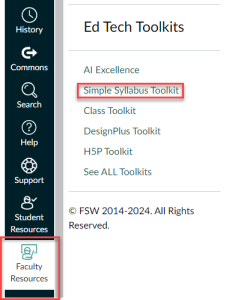The Technology Enhanced Classroom
2 Core Technology Used In Every Classroom
Welcome to the essential guide on integrating foundational educational technology at Florida SouthWestern State College (FSW). This chapter aims to equip all faculty, regardless of technical proficiency, with the necessary skills to effectively use the required technology within our Learning Management System (LMS), Canvas. These tools are critical for maintaining a consistent and impactful learning experience across our institution.
These tools include Simple Syllabus, the Attendance Verification assignment, and the Canvas Gradebook.
We will also explore elements of Canvas to make navigating Canvas and interacting with these required elements easier to accomplish. You’ll encounter information about Canvas navigation, tools to communicate with your students, setting up your course for the semester, and support resources available to you. This section is designed to provide you with the knowledge and inspiration to use these tools to their fullest for the benefit of FSW learners.
Accessing Canvas
FSW has our own instance of Canvas, which allows us to customize the global links, navigation, and tools within Canvas to a certain degree. Faculty can access Canvas through the Canvas link in the Portal or the Quick link option on the FSW Homepage.

Faculty would then sign into Canvas through the Single Sign-On option and their chosen Multi-Factor Authentication (MFA) option. Review this OIT Knowledge Base article: Multi-Factor Authentication (MFA) to learn about your MFA options.
How Does Simple Syllabus Simplify Syllabus Creation?
Simple Syllabus is designed to standardize the syllabus creation process, simplifying syllabus development and sharing of course outlines. What steps must faculty take to use this tool effectively? Initially, faculty will complete a two-step process: filling out and editing their syllabus and then submitting it for approval through the tool to their Dean or Chair before the semester begins. This process ensures consistency across courses and simplifies the modification of existing syllabi for different sections or terms.
 Key Features of Simple Syllabus:
Key Features of Simple Syllabus:
Standardization: Ensures every student receives the same foundational course information.
Efficiency: Allows for easy duplication and editing of syllabi for multiple course sections.
What Resources Support Effective Use of Simple Syllabus?
To maximize the benefits of the Simple Syllabus tool, faculty are encouraged to utilize specific resources designed to facilitate a smooth setup and deployment.
How can these resources be accessed and what do they offer?
First, the OIT Knowledge Base Article titled “How To: Setup Simple Syllabus in Canvas” provides a detailed walkthrough of locating, editing, and understanding the components of your syllabus—highlighting both mandatory and optional elements. This article is accessible through the FSW account login.
 Second, enroll in the Simple Syllabus Toolkit available in Canvas for comprehensive training and additional support resources. This toolkit can be accessed through the ‘Faculty Resources’ option in Canvas or directly via the enrollment link provided.
Second, enroll in the Simple Syllabus Toolkit available in Canvas for comprehensive training and additional support resources. This toolkit can be accessed through the ‘Faculty Resources’ option in Canvas or directly via the enrollment link provided.
Steps to Access and Use Resources:
Consult the Knowledge Base: Review the setup article to understand the syllabus creation and approval process.
Enroll in the Toolkit: Gain further insights and support by enrolling in the Simple Syllabus Toolkit for detailed guidance and best practices.
By effectively utilizing the Simple Syllabus tool and its accompanying resources, faculty can ensure that their course syllabi are not only comprehensive and clear but also aligned with institutional standards. This preparation helps in establishing a transparent and structured learning environment from the outset of the course.
Why is the Attendance Verification Quiz Important?
The Attendance Verification quiz is critical for compliance and record-keeping and as a measure of student engagement in online courses. Students are required to complete this activity to be eligible for financial aid, and it actively involves them in the learning process from the outset, establishing a pattern of participation and accountability.
Read on in the FSW Knowledge Base to learn more about the Attendance Verification Quiz in your Canvas course(s).
Why is the Canvas Gradebook Critical to Teaching?
The Canvas Gradebook goes beyond traditional grading—it’s an interactive tool that supports both instructional and administrative tasks. The Gradebook offers a comprehensive overview of each student’s performance, enabling instructors to monitor progress, identify learning gaps, and adjust teaching strategies accordingly. It also ensures that grading remains fair and transparent, crucial for maintaining trust and motivation among students.
FSW Faculty Take
“Students have consistently graded me with very high scores for both online and ground courses I teach. I grade very fast, which they really appreciate and comment to each student individually in all their written assignments. They tell me this is not the norm, but it is for me. Consistent contact and accessibility and clear goals and objectives lead to a better learning experience for the students, at least that is what they tell me.”
How do FSW Faculty Effectively Utilize the Canvas Gradebook?
Leveraging the full potential of the Gradebook involves several best practices that can transform it from a grading tool into a powerful educational ally. Here are some effective ways to use the Gradebook:
- Continuous Feedback: Use the Gradebook to provide timely and detailed feedback on assignments and assessments. This ongoing communication helps students understand their strengths and areas for improvement, fostering a growth mindset.
- Progress Tracking: Regularly update the Gradebook to reflect student scores and completion of coursework. This not only keeps students informed about their current standing but also motivates them to stay engaged with the course material.
- Analytical Insights: Utilize the analytics features of the Gradebook to gain insights into class performance trends and individual student progress. This data can guide instructional decisions, such as revisiting challenging topics or providing additional resources.
- Customization for Clarity: Customize the Gradebook settings to align with your grading scheme and course requirements. Clear categorization and weighting of assignments within the Gradebook can help students understand how their work contributes to their overall grade.
Best Practices for Implementing the Canvas Gradebook
- Consistency: Keep grading consistent and transparent. Regular updates and clear criteria help prevent misunderstandings and disputes over grades.
- Missing Assignments: Missing assignments do not count toward the final grade. Manually add a zero for assignments that are not submitted, or apply a grade book policy that automatically adds the zero.
- Accessibility: Ensure all students understand how to access and interpret their grades and feedback within the Gradebook. Consider providing a brief tutorial or guide at the start of the course.
- Feedback Quality: Strive for constructive and actionable feedback that guides students on improving their performance in future assignments.
By embracing these practices, faculty can ensure that the Gradebook is a robust tool for enhancing the educational experience, providing a clear and continuous reflection of student progress and achievement. Through effective use of the Canvas Gradebook, instructors meet institutional requirements and actively contribute to their students’ academic success.
Try It Out!
Want to see how much you’ve learned? Complete the activity below to check your understanding. No pressure—it’s just for practice and you can try it as many times as you like.
Deep Dive
Can a course syllabus be used to motivate and inspire students?
The use of Simple Syllabus at FSW provides an excellent opportunity for students to preview a course before registering. As you read the following article, reflect on your course Syllabus.
- Does the syllabus speak to a student that you trust them?
- Is the syllabus supportive, encouraging, and inviting to students who are thinking about registering for your course?
- Is the end-of-semester activity in the article something that would work in your online courses?
“Co-Creating a Syllabus”
Media Attributions
- Accessing Canvas
- It’s in the Syllabus © Firefly, Canva, & Heather Olson
- Simple Syllabus Navigation
Canvas is an online platform used by educational institutions to manage and deliver courses. It allows instructors to create, distribute, and grade assignments, facilitate discussions, and communicate with students. Canvas provides tools for organizing course content, tracking student progress, and enhancing the overall learning experience through various multimedia and interactive elements.
Definition:
The FSW Knowledge Base is Florida SouthWestern State College’s centralized online repository of articles, guides, and resources designed to support students, faculty, and staff. It offers quick access to information on a wide range of topics, including technical troubleshooting, software tutorials, instructional design, Canvas support, and institutional procedures. The Knowledge Base serves as a self-service support tool to help users find solutions independently, 24/7.
Key Features:
Searchable database of FAQs and help articles
Step-by-step guides for common academic and administrative tools
Updated regularly by IT, eLearning, and support departments
Accessible via the FSW portal or directly at https://fsw.teamdynamix.com/TDClient/2031/Portal/Home/
Use Case Example:
“Instructors can refer to the FSW Knowledge Base to learn how to embed videos in Canvas, troubleshoot Zoom issues, or access digital teaching tools.”
Simple Syllabus is an online tool used by educational institutions to create, manage, and distribute course syllabi. It streamlines the process of syllabus creation, ensuring consistency and accessibility. Instructors can easily update course information, policies, and schedules, while students can access and review their course syllabi in one centralized location.
